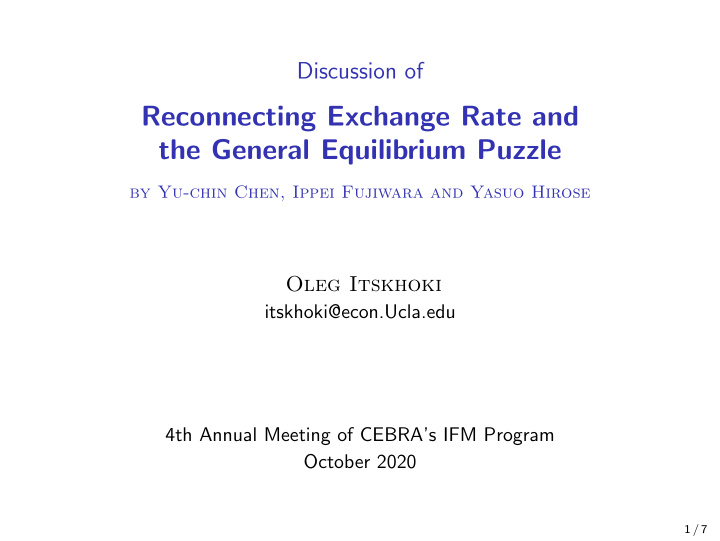



Discussion of Reconnecting Exchange Rate and the General Equilibrium Puzzle by Yu-chin Chen, Ippei Fujiwara and Yasuo Hirose Oleg Itskhoki itskhoki@econ.Ucla.edu 4th Annual Meeting of CEBRA’s IFM Program October 2020 1 / 7
Exchange Rate Disconnect • An umbrella of exchange rate properties (puzzles): 1 low correlation 2 “excess” volatility of exchange rates with/relative to macro variables: inflation − → PPP puzzle i ii consumption − → Backus-Smith puzzle iii interest rates − → Forward premium (UIP) puzzle 2 / 7
Exchange Rate Disconnect • An umbrella of exchange rate properties (puzzles): 1 low correlation 2 “excess” volatility of exchange rates with/relative to macro variables: inflation − → PPP puzzle i ii consumption − → Backus-Smith puzzle iii interest rates − → Forward premium (UIP) puzzle • All these puzzles are “unconditional” 2 / 7
Exchange Rate Disconnect • An umbrella of exchange rate properties (puzzles): 1 low correlation 2 “excess” volatility of exchange rates with/relative to macro variables: inflation − → PPP puzzle i ii consumption − → Backus-Smith puzzle iii interest rates − → Forward premium (UIP) puzzle • All these puzzles are “unconditional” • “Disconnect” is not a property of a model. It is a feature of the data! — “Reconnect” cannot happen in a model 2 / 7
Two Core Puzzles 1 Backus-Smith and UIP puzzles • exchange rates are an order of magnitude more volatile than consumption, as well as mildly negatively correlated • interest rates are smooth and persistent, while exchange rate changes are volatile and nearly iid 3 / 7
Two Core Puzzles 1 Backus-Smith and UIP puzzles • exchange rates are an order of magnitude more volatile than consumption, as well as mildly negatively correlated • interest rates are smooth and persistent, while exchange rate changes are volatile and nearly iid 2 Mussa puzzle • change from peg to float results in an order of magnitude volatility increase in real exchange rate and no change in statistical properties of consumption 3 / 7
Two Core Puzzles 1 Backus-Smith and UIP puzzles • exchange rates are an order of magnitude more volatile than consumption, as well as mildly negatively correlated • interest rates are smooth and persistent, while exchange rate changes are volatile and nearly iid 2 Mussa puzzle • change from peg to float results in an order of magnitude volatility increase in real exchange rate and no change in statistical properties of consumption • Both puzzles are about a risk-sharing frictions t +1 ) − ∆ q t +1 } = ˆ E t { σ (∆ c t +1 − ∆ c ∗ ψ t or t − E t ∆ e t +1 = ˆ i t − i ∗ ψ t — Itskhoki-Mukhin (2019a,b): segmented financial market 3 / 7
Mussa Puzzle Redux Peg Float 0.15 ✗ IRBC ∆ q t : ⇒ 0 (flex prices) -0.15 0.15 ✗ NKOE ∆ c t : ⇒ (sticky prices) -0.15 1960 1965 1970 1975 1980 1985 ⇓ ⇓ ✓ Mussa Redux ✓ ER Disconnect t − E t ∆ e t +1 = ˆ i t − i ∗ ψ t 4 / 7
Alternative Models 5 / 7
Alternative Models 5 / 7
This Paper • A number of departures from: t +1 ) − ∆ q t +1 } = ˆ E t { σ (∆ c t +1 − ∆ c ∗ ψ t 1 Complete markets instead of segmented incomplete markets 2 Epstein-Zin non-recursive utility and non-separable utility instead of separable CRRA 3 Volatility shocks to productivity and monetary policy 4 Nominal rigidities • But still: risk-sharing friction ˆ ψ t (called Ω t ) 6 / 7
This Paper • A number of departures from: t +1 ) − ∆ q t +1 } = ˆ E t { σ (∆ c t +1 − ∆ c ∗ ψ t 1 Complete markets instead of segmented incomplete markets 2 Epstein-Zin non-recursive utility and non-separable utility instead of separable CRRA 3 Volatility shocks to productivity and monetary policy 4 Nominal rigidities • But still: risk-sharing friction ˆ ψ t (called Ω t ) • This mechanism goes a long way/some way in replacing exogenous wedge ˆ ψ t (Ω t ) — reduces its contribution to ER volatility from 86% to 56% — yet, cannot deliver the Fama regression properties in the absence of Ω t 6 / 7
One comment • OPEN UP THE BLACKBOX! 7 / 7
One comment • OPEN UP THE BLACKBOX! • Which ingredients matter: 1 Why these subset of shocks instead e.g. long-run risk, rare disasters or long-run productivity news? 2 What is the role of sticky prices? (maybe for Mussa puzzle) 3 Complete vs incomplete markets? 4 Backus-Smith vs UIP puzzle? 7 / 7
One comment • OPEN UP THE BLACKBOX! • Which ingredients matter: 1 Why these subset of shocks instead e.g. long-run risk, rare disasters or long-run productivity news? 2 What is the role of sticky prices? (maybe for Mussa puzzle) 3 Complete vs incomplete markets? 4 Backus-Smith vs UIP puzzle? • Conditional puzzles and conditional moments — e.g., does UIP hold condition on a level monetary shock, in the model and in the data? — are shocks correlated: e.g., a level monetary policy shock induces a risk premium shock (see Alvarez-Atkeson-Kehoe) 7 / 7
Recommend
More recommend